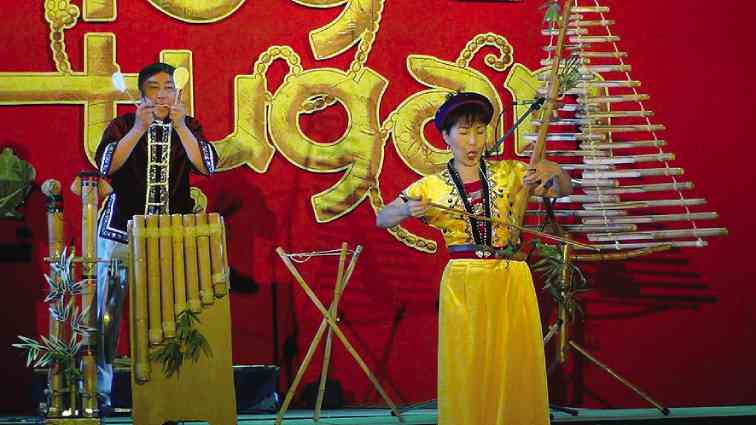
The music borne out of playing gongs and bamboo instruments cannot simply be dismissed as an obfuscated form of entertainment, for it has always been a mirror of “a life of spirituality, subsistence, and of communing with nature in this part of the world,” said National Artist-designate Ramon P. Santos during the first international gongs-and-bamboo music festival, held Feb. 19-22 in Dipolog City, Zamboanga del Norte.
“There’s a need to trace the roots of these musical traditions in Southeast Asia to fully appreciate and explore their significance,” he added.
Santos was director of the festival, “Tunog-tugan,” which gathered over 200 artists and scholars of gong-and-bamboo music from at least 11 countries in Asia and elsewhere. Output from the interaction between artists and scholars will be used in formulating instructional materials about traditional music, according to organizers.
Tunog-tugan was part of the Philippine Arts Festival (PAF) in connection with the National Arts Month celebrations last February.
Tradition, academe
Organized by the National Commission for Culture and the Arts (NCCA) through the Musicological Society of the Philippines, University of the Philippines Center for Ethnomusicology, and City Government of Dipolog, Tunog-tugan sought to promote awareness on gong-and-bamboo music in schools and other academic institutions.
Because of this, according to Santos, outreach performances in other municipalities in Zamboanga del Norte were held as part of the festival, on top of the two-day conference and workshops attended by scholars from even as far as France and Hawaii.
“We have asked our artists to perform in schools outside Dipolog, so that people, especially the youth in those communities, may experience our traditional gong-and-bamboo music,” Santos said. “This promotion is also part of an effort to preserve our culture.”
Outside Dipolog City, local and foreign gong-and-bamboo musicians alike performed in Sindangan, Siayan, Sapang Dalaga, Rizal, Dapitan City and Manukan.
Well-received performances
Four performing groups showcased their art during the first night after the opening ceremonies.
The Dipolog City Bamboo Marimba Ensemble, a national winner in the National Music Competitions for Young Artists, delivered masterful renditions of songs using bamboo marimbas, claves, and a triangle.

Among the pieces they performed were the dance music “Can-Can,” composed by J. Offenbach; the Pizziccato Polka, which had originally been composed for stringed instruments in 1892 for the concerts of Eduard Strauss in Hamburg; and “Nais Ko,” by master composer Ryan Cayabyab.
Exciting the crowd further were the comic acts of a Vietnamese duo known as Khac Chi Music: Ho Khac Chi, the world’s premier virtuoso on the dan bau, a one-string zither, who had taught at the Vietnam Conservatory of Music before traveling to perform traditional music in Europe, US and Asia; and Hoang Ngoc Bic, the first woman to win First Prize on the dan bau in the Vietnam Competition of Professional Instrumentalists and also the first woman ever to play the koni, a two-string stick fiddle.
Shamanistic rhythms
The duo played “Full Moon Dance,” a traditional Vietnamese highlander music, arranged by Khac Chi to suit it with the sound of a bamboo xylophone and the dinh pa, a bamboo pipe. The duo also presented “Love under the Moonlight,” a folk song of mountain people played with a long flute which can be blown at the same time by two performers.

Meanwhile, the Maguindanao Kulintang Ensemble performed pieces dedicated to familiar Filipino traditions: “Kaluntang,” a song played by farmers during harvest time; “Kaganding sa Kulndet,” a fast rhythmic song played with only three gongs during weddings in Maguindanao; and “Sagayan,” a shield-and-sword male dance performed during wedding processions.
The lively presentations of the Korean Noreum Machi, which specializes in playing percussion music known as Samul-nori, a modern adaptation of the ancient rituals of Pungmul-nori farmers, closed the first night.
The members played instruments and danced to the tune of “Binari,” a song-prayer to drive away misfortune and bring wealth, glory and long life; and “Noreummachi Sinawi,” the culminating act with the four percussions kkwaenggwari, jing, jang-gu and buk played alternately in even and odd meters to resemble a mixture of shamanistic rhythms.
Emblematic start
The festival kicked off with a very meaningful inter-faith prayer, led by Filipino youth from the indigenous peoples of the North, the Lumads of the South, and Muslims and Christians.
NCCA chair Felipe de Leon Jr., himself a musician and head of the NCCA National Committee on the Arts, formally opened the festival.
Before that, a colorful procession of international ensembles, troupes, and duo of musicians signaled the start of the festival inside the massive Dipolog Sports Complex.
Parading were the foreign guest performers, including the Senandong Budaya of Brunei Darussalam; Ensamble Modero Palu of Indonesia; Persatuan Seni Budaya Sabah of Malaysia; Noreum Machi of the Republic of Korea; Taiwan Bamboo Orchestra of Taiwan; Prasarnmit Performing Arts Alliance of Thailand; and Khac Chi Bamboo Music from Vietnam and Canada.
Equally talented local artists also paraded: Cordillera Music Tutorial and Research Center (Baguio City); Ifugao Performing Arts Group (Ifugao); Panay Bukidnons (Panay island); Maguindanao Kulintang Ensemble (Cotabato City); Teduray Agong Ensemble (Maguindanao); Dipolog City Bamboo Marimba Ensemble (Dipolog City); Bagobo Clata (Davao City); Roxas Ahadas Yakan Music Cultural Group (Basilan); Ingat Kapandayan Artist Center (Sulu); and the Subanens, the indigenous group in Zamboanga del Norte, who treasure their long history of making music with gongs and were represented in the festival by the Subanen of Siayan, Pusakani Datu Tangkilan and the Gbata Dlepuyan Dance Troupe.













































